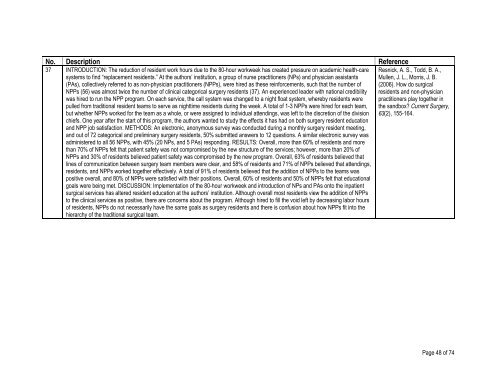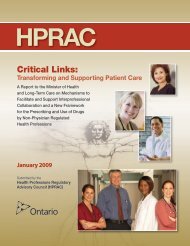No. Description Reference35 Background: In the United States, the physician assistant (PA) model has proven to be a cost-effective way to train quality primarycare providers with a high degree of acceptance of the PA role by patients and other healthcare providers. The PA is a healthprofessional licensed to practice medicine in the United States. Within the physician–PA relationship, physician assistants exerciseautonomy in medical decision-making and provide a broad range of diagnostic and therapeutic services. These include physicalexamination, diagnosing and treating illnesses, ordering and interpreting tests, counselling on preventive healthcare, assisting insurgery, and writing prescriptions. <strong>Physician</strong> assistants are also involved in education, research and administrative services. PAeducation is based on the medical model which aims to create a physician–PA team that enhances the delivery of high-qualityhealthcare. The legal basis of physician assistant practice is the concept of delegation of medical tasks by licensed physicians toqualified professionals. PAs work with the supervision of physicians and practice in a variety of clinical settings including rural clinics,multi-specialty group practices, community health centers and hospitals. Aim: Discuss PA model as it pertains to other countries.Methods: <strong>Review</strong> of relevant literature related to physician assistant education, practice and global interest. Results: Severalcountries including the United Kingdom, Scotland, Canada, the Netherlands, Taiwan, South Africa and Ghana are exploring or reexploringthe concept of the physician assistant as a way to quickly and efficiently train and employ autonomous and flexible healthworkers to address their nation’s healthcare needs. The general medical education of PAs gives them the ability to move betweenvarious clinical settings and specialties including clinics, medical centers and hospitals. In all settings they share in diagnosing andtreating common medical problems and providing preventive care and health education. PAs are also utilized in all of the surgicalspecialties and the majority of the medical specialties. PAs have been shown to have proficiency in the performance of medicaldiagnostic and therapeutic procedures that require a high degree of technical proficiency. Conclusions: <strong>Physician</strong> assistant educationis efficient and flexible and the PA model can be easily adapted to the specific health system needs of other nations. In addition,many PA programs have affiliation agreements with institutions outside of the United States to host PA students for clinical rotationsand there is an ever-growing interest by students in international rotations. The <strong>Physician</strong> Assistant Education Association along withthe American Academy of <strong>Physician</strong> <strong>Assistants</strong> is actively involved with sharing information about the PA profession with othercountries.36 <strong>Physician</strong> assistants (PAs) and nurse practitioners (NPs) were introduced in the United States in 1967. As of 2006, there are 110 000clinically active PAs and NPs (comprising approximately one sixth of the US medical workforce). Approximately 11 200 new PAs andNPs graduate each year. PAs and NPs are well distributed throughout primary care and specialty care and are more likely thanphysicians to practise in rural areas and where vulnerable populations exist. A growing number of NPs and PAs are employed inhospitals. Most are employed by the institution or a doctor, and are usually viewed as part of a two-person medical or surgical team.In general, PAs and NPs in hospitals can prescribe narcotics, undertake procedures, and direct patient care with fewer restrictionsthan in outpatient settings. About 30% of PAs report having some type of hospital relationship. In some instances, NPs and PAsserve as inpatient specialists or “hospitalists”, providing “back-fill” for junior hospital doctors who are no longer working extendedhours, or providing care previously covered by junior doctors. The productivity of NPs and PAs, based on traditional doctor services,is comparable, and the range of services approaches 90% of what primary care physicians provide. The education time isapproximately half that of a medical doctor and entry into the workforce is less restrictive. The interprofessional skill mix provided byPAs and NPs may enhance medical care in comparison with that provided by a doctor alone.Legler, C. F., Cawley, J. F., &Fenn, W. H. (2007). <strong>Physician</strong>assistants: Education, practiceand global interest. MedicalTeachers, 29, e22-e25.Hooker, R. A. (2006). <strong>Physician</strong>assistants and nursepractitioners: The United Statesexperience. Medical Journal ofAustralia, 185, 4-7.Page 47 of 74
No. Description Reference37 INTRODUCTION: The reduction of resident work hours due to the 80-hour workweek has created pressure on academic health-caresystems to find “replacement residents.” At the authors’ institution, a group of nurse practitioners (NPs) and physician assistants(PAs), collectively referred to as non-physician practitioners (NPPs), were hired as these reinforcements, such that the number ofNPPs (56) was almost twice the number of clinical categorical surgery residents (37). An experienced leader with national credibilitywas hired to run the NPP program. On each service, the call system was changed to a night float system, whereby residents werepulled from traditional resident teams to serve as nighttime residents during the week. A total of 1-3 NPPs were hired for each team,but whether NPPs worked for the team as a whole, or were assigned to individual attendings, was left to the discretion of the divisionchiefs. One year after the start of this program, the authors wanted to study the effects it has had on both surgery resident educationand NPP job satisfaction. METHODS: An electronic, anonymous survey was conducted during a monthly surgery resident meeting,and out of 72 categorical and preliminary surgery residents, 50% submitted answers to 12 questions. A similar electronic survey wasadministered to all 56 NPPs, with 45% (20 NPs, and 5 PAs) responding. RESULTS: Overall, more than 60% of residents and morethan 70% of NPPs felt that patient safety was not compromised by the new structure of the services; however, more than 20% ofNPPs and 30% of residents believed patient safety was compromised by the new program. Overall, 63% of residents believed thatlines of communication between surgery team members were clear, and 58% of residents and 71% of NPPs believed that attendings,residents, and NPPs worked together effectively. A total of 91% of residents believed that the addition of NPPs to the teams waspositive overall, and 80% of NPPs were satisfied with their positions. Overall, 60% of residents and 50% of NPPs felt that educationalgoals were being met. DISCUSSION: Implementation of the 80-hour workweek and introduction of NPs and PAs onto the inpatientsurgical services has altered resident education at the authors’ institution. Although overall most residents view the addition of NPPsto the clinical services as positive, there are concerns about the program. Although hired to fill the void left by decreasing labor hoursof residents, NPPs do not necessarily have the same goals as surgery residents and there is confusion about how NPPs fit into thehierarchy of the traditional surgical team.Resnick, A. S., Todd, B. A.,Mullen, J. L., Morris, J. B.(2006). How do surgicalresidents and non-physicianpractitioners play together inthe sandbox? Current Surgery,63(2), 155-164.Page 48 of 74
















